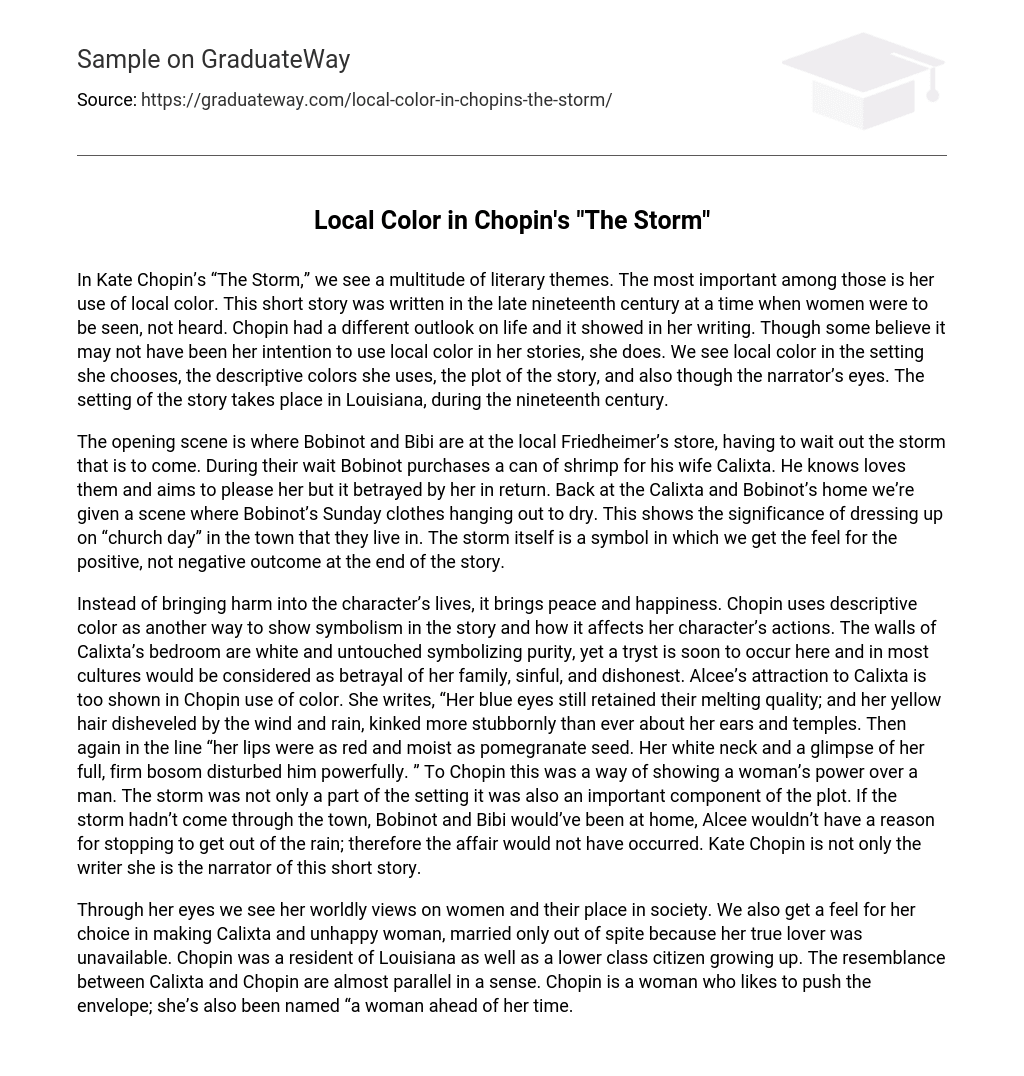In Kate Chopin’s “The Storm,” we see a multitude of literary themes. The most important among those is her use of local color. This short story was written in the late nineteenth century at a time when women were to be seen, not heard. Chopin had a different outlook on life and it showed in her writing. Though some believe it may not have been her intention to use local color in her stories, she does. We see local color in the setting she chooses, the descriptive colors she uses, the plot of the story, and also though the narrator’s eyes. The setting of the story takes place in Louisiana, during the nineteenth century.
The opening scene is where Bobinot and Bibi are at the local Friedheimer’s store, having to wait out the storm that is to come. During their wait Bobinot purchases a can of shrimp for his wife Calixta. He knows loves them and aims to please her but it betrayed by her in return. Back at the Calixta and Bobinot’s home we’re given a scene where Bobinot’s Sunday clothes hanging out to dry. This shows the significance of dressing up on “church day” in the town that they live in. The storm itself is a symbol in which we get the feel for the positive, not negative outcome at the end of the story.
Instead of bringing harm into the character’s lives, it brings peace and happiness. Chopin uses descriptive color as another way to show symbolism in the story and how it affects her character’s actions. The walls of Calixta’s bedroom are white and untouched symbolizing purity, yet a tryst is soon to occur here and in most cultures would be considered as betrayal of her family, sinful, and dishonest. Alcee’s attraction to Calixta is too shown in Chopin use of color. She writes, “Her blue eyes still retained their melting quality; and her yellow hair disheveled by the wind and rain, kinked more stubbornly than ever about her ears and temples. Then again in the line “her lips were as red and moist as pomegranate seed. Her white neck and a glimpse of her full, firm bosom disturbed him powerfully. ” To Chopin this was a way of showing a woman’s power over a man. The storm was not only a part of the setting it was also an important component of the plot. If the storm hadn’t come through the town, Bobinot and Bibi would’ve been at home, Alcee wouldn’t have a reason for stopping to get out of the rain; therefore the affair would not have occurred. Kate Chopin is not only the writer she is the narrator of this short story.
Through her eyes we see her worldly views on women and their place in society. We also get a feel for her choice in making Calixta and unhappy woman, married only out of spite because her true lover was unavailable. Chopin was a resident of Louisiana as well as a lower class citizen growing up. The resemblance between Calixta and Chopin are almost parallel in a sense. Chopin is a woman who likes to push the envelope; she’s also been named “a woman ahead of her time. ” She was flirtatious with married men, she smoked, and she drank and chose to live on the wilder side of life.
During the nineteenth century it wasn’t uncommon for a woman to be unhappy in her marriage because marriages were either arranged by the parents or you were forced into marriage due to your society’s beliefs. This was the Victorian age after all. Chopin wanted to show readers that it was okay to live life according to how you felt and not just on what others viewed as acceptable in a society. In my opinion the use of local color in story telling is a good way to understand the characters, where they come from and why they make the choices that they make. It shows you the meaning and importance behind realism.
It was widely used amongst all writers during this time and I believe their stories wouldn’t have been the same without it. I personally enjoyed Kate Chopin’s short story. Local opens your eyes to a specific culture and how those people in that culture live and why they choose to live that way. Local color can be used in other forms of writing such as poetry as well. In this short story Chopin uses it in the setting, through descriptive colors, the plot and through her own eyes. The writers of her time couldn’t have done what she did with “The Storm” and still made it as unforgettable as she did.





